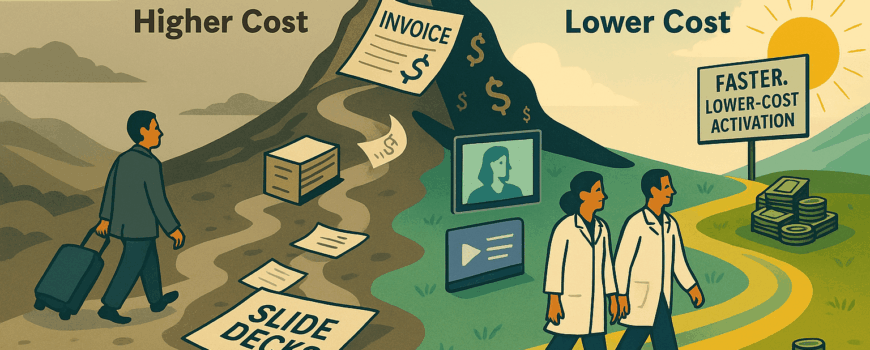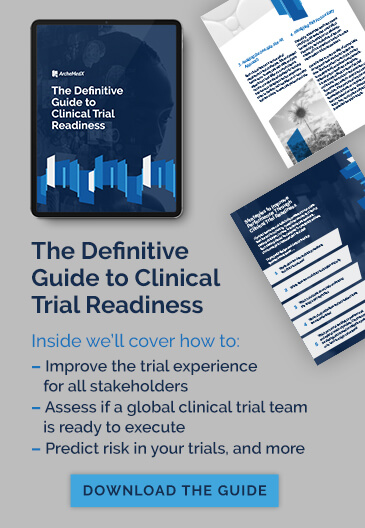Clinical trials aren’t just more complex. They’re harder to manage, more expensive to run, and increasingly exposed to delay and disruption.
Sponsors and CROs are being squeezed from every direction. Funding cycles have slowed. Site costs are rising as inflation and staffing gaps hit harder. And the FDA keeps shifting expectations in ways that create new uncertainty.
In this environment, traditional practices fall short. Live investigator meetings, static slide decks, and reactive oversight were once seen as safe. Now they’re too slow, too costly, and too vulnerable to breakdown.
Sponsors can no longer afford to rely on outdated methods to manage today’s challenges. To stay ahead, they need to act sooner, train smarter, and make better informed decisions earlier in the study. That’s how Sponsors can reduce risk and manage costs more effectively without sacrificing quality.
The Pressure Is Real and Growing
Trial sponsors are navigating some of the most difficult conditions the industry has faced in years.
Biotechs are raising smaller rounds, if they can raise at all. CFOs and investors are demanding clear returns on every dollar spent. Increasingly complex procedures and data requirements are driving up costs. CROs are offering fewer fixed-fee contracts and shifting more risk and cost back to the sponsor.
And then there’s the regulatory picture. The FDA continues to delay decisions, raise questions about AI and decentralized models, and move the goalposts on endpoints and evidence. The bar keeps rising, but the resources aren’t.
Sponsors are being asked to do more with less. To succeed, they need to rethink how they prepare, train, and manage their studies from day one before costs escalate and delays mount.
The Hidden Costs That Drive Trial Budgets Up
Many sponsors still treat site activation and study startup as a checklist. As long as the investigator meeting happens, the slide deck gets sent, and the SIV checks the training box, they assume the site is ready. But this surface-level readiness is where trial budgets quietly start to unravel.
When training doesn’t stick, problems show up later. Teams spend more time responding to questions, clarifying procedures, and retraining staff. Sites misinterpret protocols, which leads to screen fails and deviations. CRAs log more hours just trying to catch issues in time. Spending resources in this circular reaction mode pulls them away from proactive oversight which increases risk and budget.
And those costs add up fast. A few extra hours of CRO time. A single site that misses enrollment targets. A protocol amendment that forces everyone back through the same slow training loop. These aren’t always surprises. Too often, they’re already priced into the budget and accepted as unavoidable. But they don’t have to be.
More sponsors are starting to recognize these hidden costs early and take steps to avoid them. The ones who get it right don’t just save money. They start replacing waste with efficiency, rework with readiness, and reactive firefighting with proactive oversight.
What High-Performing Sponsors Are Doing Differently
Some sponsors aren’t waiting for budget relief or regulatory clarity. They’ve already changed the way they run trials and they’re seeing real results.
Instead of defaulting to in-person meetings and generic slide decks, they’re delivering role-based training on demand. Instead of chasing down documentation after the fact, they’re capturing it automatically. And instead of reacting to issues after they happen, they’re identifying risks earlier and stepping in before timelines slip.
These sponsors are improving quality, shortening timelines, and lowering costs. They’re also reducing friction for sites and CRO partners — and that makes it easier to keep teams aligned and trials on track.
What separates these teams isn’t just better technology. It’s a better mindset. They’ve moved past the idea that trial startup is just a checklist, and they treat training as a lever for improved execution, not a regulatory formality.
The Sponsors Already Saving Time and Money
Sponsors who’ve adopted a more proactive approach aren’t just improving quality, they’re also cutting real costs across every phase of the study.
Let’s take two representative examples:
Example 1: A Phase 2 study with 30 sites across the US and Australia, running for 18 months with one major protocol amendment.
By using modern, interactive training and reducing reliance on in-person meetings, the sponsor saved:
- Over $350,000 in CRO billable hours, travel, and meeting prep.
- More than 300 hours of staff time through automated documentation and site onboarding.
- Roughly 25% fewer deviations due to clearer training and better protocol comprehension.
Example 2: A global Phase 3 trial with 150 sites in over 20 countries, running for 3 years with two protocol versions and frequent team turnover.
By shifting to role-based, on-demand training and enabling early insight into site readiness, the sponsor avoided:
- Nearly $2.5 million in costs tied to travel, site delays, and CRO overages.
- Weeks of delay in site activation timelines across multiple regions.
- Costly retraining efforts due to protocol changes or staff turnover.
These savings aren’t theoretical. They’re based on real inputs from real trials. The biggest wins often come from solving problems before they show up in the budget and that starts with how training and oversight are handled up front.
The Numbers Behind the Change
The cost savings from rethinking trial startup and execution are no longer theoretical. Sponsors adopting a more modern, data-driven approach are consistently saving hundreds of thousands — and in many cases, millions — depending on the size and complexity of the study.
Here’s where those savings typically come from, based on real trial data:
- Shorter SIVs and IMs
Shifting from in-person to hybrid or virtual delivery cuts meeting prep, travel, and logistics. For a 50-site study, the savings can exceed $300,000 across investigator meetings and site initiation visits. - Fewer protocol deviations
Better upfront training helps site staff retain critical information. Avoiding deviations at each site can save more than $125,000 in combined rework and CRA time. - Improved onboarding
Automating onboarding for new CRAs, site staff, and project team members reduces ramp-up time. Sponsors regularly save $50,000 to $100,000, especially on long studies with staff turnover. - Streamlined amendment training
Sponsors using Ready for protocol updates avoid duplicative meetings and rework. Even a single amendment in a 30-site study can cost more than $75,000 if handled the old way. - Lower screen failure rates
With more effective training and clearer guidance, sites screen smarter. Reducing unnecessary screening by just 10% can avoid $250,000+ in lost recruitment and site payments. - More efficient rater and evaluator training
Standardizing training across evaluators helps minimize bias and inconsistency. Sponsors often reduce the need for reassessments and save over $100,000 in CRO hours and downstream costs. - Less firefighting, more foresight
Perhaps the biggest ROI: identifying and fixing readiness gaps before activation. Sponsors avoid costly delays, keep enrollment on track, and reduce downstream escalations.
These aren’t savings you have to wait 18 months to realize. Most start showing up in the first 30 to 60 days after shifting to a more proactive approach.
The Case for Rethinking How Trials Are Run
The challenges sponsors face today don’t have to result in higher costs, slower timelines, or greater uncertainty. From small biotechs to large global teams, those embracing more modern approaches are already seeing faster activations, fewer errors, stronger oversight, and meaningful cost savings.
These results aren’t hypothetical, they’re happening right now.
This is the moment to re-evaluate what truly drives value and what’s holding teams back. It begins by rethinking how trials are prepared, how teams are trained, and how oversight is delivered. It continues by applying behavioral science, operational data, and tools that help teams move faster and work smarter.
The pressure may be mounting, but so is the opportunity. Sponsors willing to take a different path can deliver faster, higher-quality trials at a lower cost.




